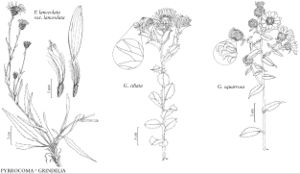Grindelia squarrosa
Mém. Mus. Hist. Nat. 5: 50. 1819.
Biennials, perennials, or subshrubs (perhaps flowering first-year, usually short-lived), (10–) 40–100 cm. Stems erect, usually whitish or stramineous, sometimes reddish or grayish, glabrous. Cauline leaf-blades oval, ovate, obovate, or oblong to spatulate, oblanceolate, lanceolate, or linear, (10–) 15–70 mm, lengths 2–5 (–10) times widths, bases ± clasping, margins usually crenate to serrate (teeth mostly 3–6+ per cm, rounded to obtuse, resin-tipped), rarely entire, apices obtuse to acute, faces glabrous, strongly gland-dotted. Heads usually in open to crowded, corymbiform arrays, rarely borne singly. Involucres broadly urceolate to hemispheric or globose, 6–11 × 8–20+ mm. Phyllaries in 5–6 series, reflexed to spreading or appressed, filiform or linear to lance-linear or lance-subulate, apices usually looped to hooked, sometimes recurved to nearly straight, subterete to subulate, moderately to strongly resinous. Ray-florets 0 or (12–) 24–36 (–40); laminae 8–14 mm. Cypselae whitish, stramineous, brown, or gray, 1.5–4.5 mm, apices smooth, coronate, or knobby, faces smooth, striate, or ± furrowed; pappi of 2–3 (–8), straight or contorted to curled, smooth or barbellulate to barbellate, subulate scales or setiform awns 2.5–5.5 mm, shorter than disc corollas. 2n = 12.
Phenology: Flowering Jul–Sep(–Oct).
Habitat: Disturbed sites, plains, hills, roadsides, along streams, sands, clays, and subalkaline soils
Elevation: (10–)200–2900 m
Distribution

Alta., B.C., Man., Ont., Que., Sask., Ariz., Ark., Calif., Colo., Conn., Del., D.C., Idaho, Ill., Ind., Iowa, Kans., Ky., Maine, Md., Mass., Mich., Minn., Mo., Mont., Nebr., Nev., N.H., N.J., N.Mex., N.Y., N.Dak., Ohio, Okla., Oreg., Pa., R.I., S.Dak., Tex., Utah, Vt., Va., Wash., Wis., Wyo., Mexico (Chihuahua), in Asia (Ukraine)
Discussion
Grindelia squarrosa is probably native to the Great Plains and, perhaps, Rocky Mountain areas; it is widely introduced in other areas. Some plants are intermediate between it and G. hirsutula (i.e., between G. squarrosa and G. perennis, which has been treated as a variety of G. squarrosa). Plants of G. squarrosa with relatively narrow leaf blades (lengths mostly 5–8 times widths), mostly from the western part of the range of the species, have been treated as G. squarrosa var. serrulata. G. L. Nesom (1990i) and others have treated discoid plants included here in G. squarrosa as distinct (as G. aphanactis, G. nuda, and/or G. nuda vars. aphanactis and nuda); Nesom reported cypselae to be dimorphic in heads of radiate plants and monomorphic in discoid plants and noted that populations with discoid plants occur mostly south and west of populations with radiate plants. According to Nesom, plants of G. nuda with stems usually reddish (versus sometimes greenish), lengths of blades of mid-cauline leaves 4–10 (versus 1.5–4) times widths, and cypselae ± deeply furrowed (versus striate to shallowly furrowed) should be called G. nuda var. aphanactis.
Hybrids between Grindelia squarrosa (nuda) and G. arizonica have been recorded from Arizona and New Mexico.
Selected References
None.
